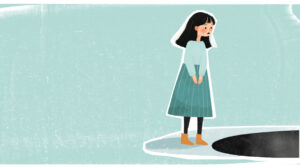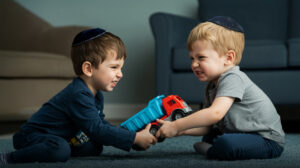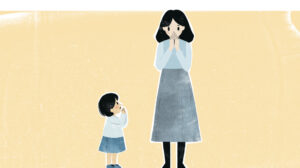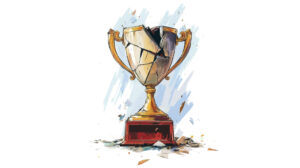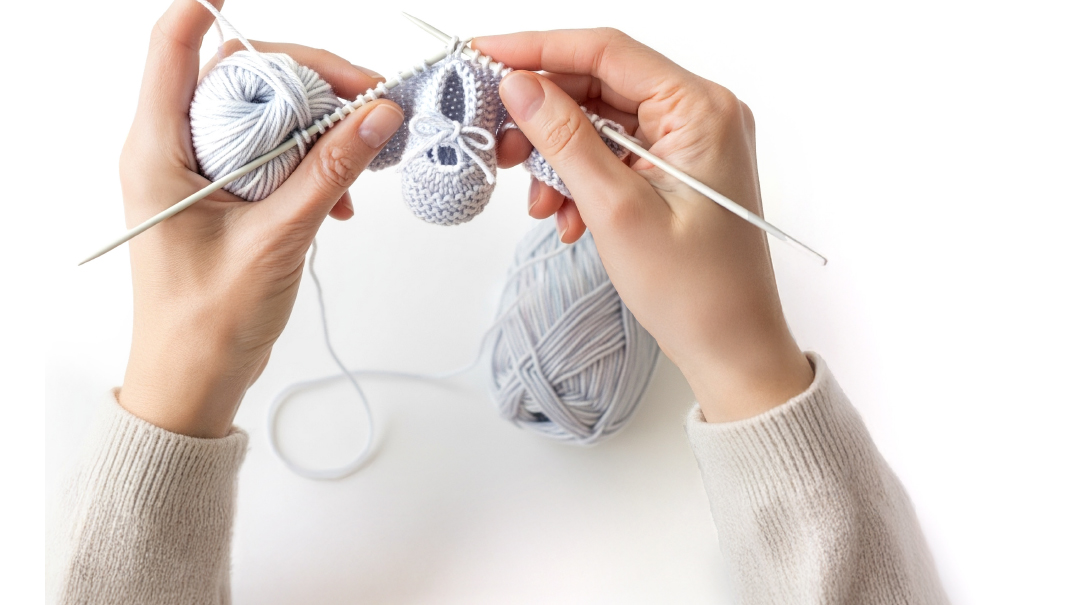A Family Reunion (for 500)
| December 12, 2012Your long lost second cousin might be your boss, your sheitelmacher, or your daughter’s teacher. At mega-family reunions people are meeting friends and acquaintances that they never knew were part of their mishpachah.
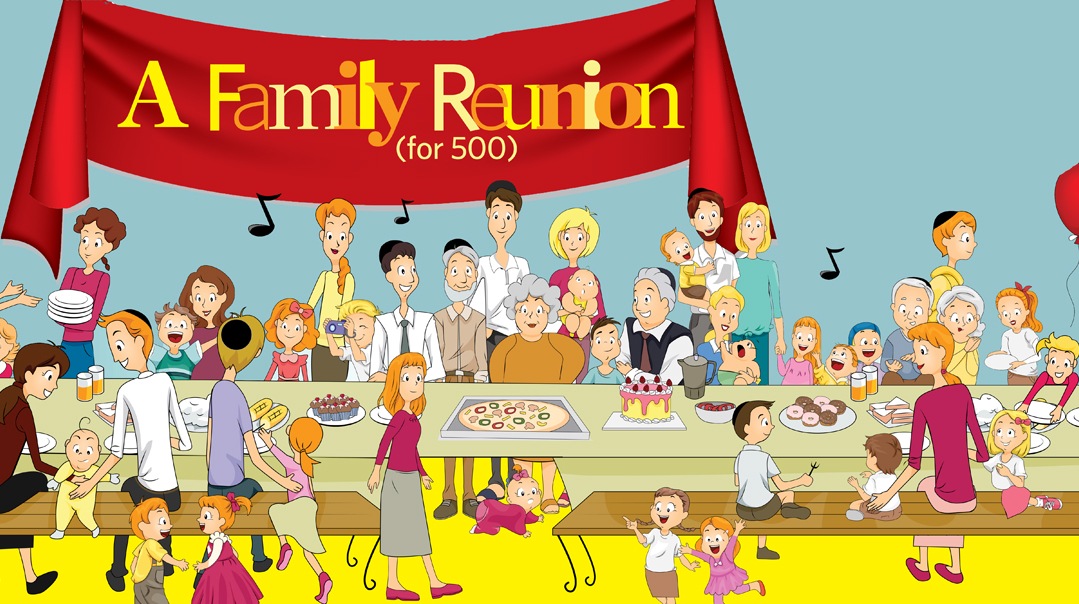
W
hen a barber in Lakewood recently attended a mega-family reunion to meet distant relatives, he realized that he recognized quite a few faces. “I probably give haircuts to half the people here,” he remarked. Before they were customers, now they were cousins. “I hope they don’t all start asking for a family discount,” he joked.
Whether it’s a large-scale family reunion for 150 or 650, attendees have been surprised to meet people they never knew were part of their greater mishpachah. Teachers have bumped into students, employees have encountered bosses or coworkers, yungeleit have run into chavrusas. Some people have been introduced to a cousin or two (or three or four or more) with the exact same name. At the Schwimmer family affair, for instance, there were swarms of young Haddasahs and Esther Malkas, all named for their joint great-grandmother.
Despite the spread of generations at these events, family is family. “When everyone gets together,” says Fally Klein of the Schwimmer family, “there are certain characteristics that keep on cropping up. We all laugh at each other, ‘you’re such a Schwimmer.’$$$seperatequote$$$”
If you’ve ever planned a reunion for just your immediate family, you know how difficult it can be. Finding a date that works for everyone can take weeks, even months. Where will the reunion take place? In what city? In whose home or in what kind of venue? What food should be served (taking into account allergies, doctor-prescribed diets, and different kashrus stringencies)? What special events should be scheduled? Where will everyone stay? How will everyone get there? How do you split the costs, especially when some relatives are better off than others?
Now imagine planning a reunion where you invite over 1,000 relatives. The complications and difficulties multiply exponentially. Though it takes a lot of people to pull together such a mammoth event, it usually starts with just one inspired individual.
The Sparkplug
To make a mega reunion happen, you need a macher to compel, cajole, and convince both close and distant cousins to help reunite the mishpachah.
Hindy Friedman initiated and coordinated two mega reunions, first for her father’s side, the Reisz family, and one for her mother’s side, the Steins. “I always dreamed about arranging this type of affair,” she says. “On the spur of a moment, I called a meeting with my [Stein] cousins to discuss the idea. They were just as excited, but when they went home, their husbands laughed and said that it wouldn’t work.” Her initial enthusiasm corroded as cousins called with negative flak, but a few staunch supporters kept the plans on the table. “Even if only 200 people come, and not the 500 cousins we’ll invite, it will still be worth it,” her husband encouraged.
Mrs. Friedman and her volunteer staff of dedicated cousins put in months of hard work. From major tasks (like hall rental) to minor (like coat rack rental), they arranged everything. The day finally arrived — Sunday, the 29th of Kislev, 2011. As they set up the hall, they wondered, Will anyone come?
Finally, one invitee arrived, followed by another and then another. Slowly the trickle grew to a stream, and then the stream to a flood. The Stein family mega-reunion was attended by hundreds of people — litvish, chassidish, modern, and non-religious — all members of an extended family. The outer trappings were disregarded. Blood is thicker than the color and fabric of a yarmulke.
“Despite the initial opposition,” Mrs. Friedman says, “every person in the New York area came. Cousins even came from Montreal and Toronto. First they all had excuses why they couldn’t and wouldn’t come. But once they got their invitations, the excitement built, and even people who I never dreamed would come ended up attending.”
In another family, the initial criticism about the proposed get-together was that it would cause bittul Torah. So the reunion organizers approached a gamut of gedolim — chassidishe and litvishe — to satisfy all branches of the family. The gedolim gave them an enthusiastic go-ahead and brachos for the reunion’s success.
Rav Matisyahu Solomon, Mashigiach of Beth Medrash Govoha, even spoke at one mega-family reunion, endorsing the event and highlighting the advantages of family. He quoted the Meshech Chachma in relation to yovel: “The pasuk in Parshas Behar states, ‘Each man should return to his original nachlah and to his family.’ The Torah wants people to go back to their roots, back to their original places … at least once in 50 years. We should strengthen the bond, strengthen the traditions, remind each other where we come from, what were our values, what were our priorities.
“And, yes, talking, discussing, remembering and — for the younger generations who don’t remember — relating, passing on memories of maasei avos and maasei imahos. Is that not the foundation of Klal Yisrael? Forefathers, foremothers that is the bedrock of our lives. That’s the only guarantee for our future. The younger generation should get together with those who are still alive amongst us, who can give over experiences, examples, tell us what our roots really mean.”
A One-of-a-kind Affair
There is no standardized template for putting together a family reunion of the “mega” magnitude. The diverse locations, programs, and even invitees highlight the uniqueness of each family.
The Felsenstein family reunion, for instance, was kicked-off with a Thursday night smorgasbord affair and included sophisticated programming spread out over a long-weekend in the Hyatt Regency hotel in Jerusalem. In contrast, the annual Schwimmer pre-Chanukah party is always a potluck affair with bagels and whatever else the family members want to prepare, held in a small hall.
One family’s mega-reunion was centered on the yahrtzeit of a great-grandmother. The chief part of the program was multiple siyumim of mishnayos made l’iluy neshamsa. This affair had a more serious tone, and no children were invited. In contrast, the Reisz and Stein affairs included children’s entertainment — pizza, popcorn, cotton candy, and a clown show.
There’s no limit to how many generations back a reunion organizer can go in order to send out his invitations — the further back, the more invitees and attendees. The size of the family reunion doesn’t seem to tarnish the warm feelings it engenders. The Schwimmer reunion was attended by 100 to 150 people, the Stein’s by 500 and the Felsenstein’s by 650, yet the participants all felt the same warmth at the event.
To encourage distant cousins to get to know each other, the Felsenstein organizers assigned table number based on age. Other reunions were laissez-faire, sit with whom you like, speak to whom you like, and meet new cousins — or don’t.
“It brought us one step closer,” remarked Moishe, a fourth generation attendee at the Stein family reunion. “Even if we didn’t get to know all the cousins, it did forge a bond.”
Blima, who flew from Israel to America to attend her family’s get-together, feels the same. “The event was an amazing experience — one room with so many people who were all related to me.”
At one family reunion, some men started singing a tune, “Nah, nah, nah, nah …” The hall hushed immediately. Everyone there — regardless of affiliation or age — recognized the tune, but from where? “It’s Zeidy’s niggun!” someone finally said, identifying the melody that had made its way down the generations into all branches of the family tree. The hall was charged with emotion as the hundreds of attendees were stirred by the emotions the tune evoked.
Pinky Stein, the keynote speaker at the Stein reunion, spoke movingly about how their family event served as a victorious rejoinder to Hitler and his Nazi henchman. The hundreds of attendees were all descendants of Pinchas and Hinda Stein, who were killed in Auschwitz along with their parents.
He told the story about the Ponevezher Rav’s visit to the Arch of Titus in Rome. Gazing at the triumphant relief depicting the spoils of Jerusalem etched into its southern panel, the Rav called out in Yiddish, “Titus, Titus. Do you see me? I’m still here. Tell me, where are you today?”
Facing a crowd of 500 family members, Mr. Stein posed a similar question: “Hitler, Hitler. Do you see us? We’re still here. Where are you today?”
It’s our fervent wish that of all the mega reunions, the biggest is the most imminent — Location: Eretz Yisrael. Time: Soon, very soon... “Sparkplug”: Mashiach.
THE WHO, WHAT, WHEN, AND HOW
Tips from reunion organizers on putting together a family fête for 100, 500, or more:
Head Count
“This is an essential starting point for all reunion plans,” says Hindy Friedman. “I thought that the Reisz family would number around 500, but they were actually 700, and the Steins were 500 people, not the 300 I thought they would be.” Once you know numbers, a lot of other details fall into place — such as how big of a venue you’ll need, how many tables and seats to rent, how many invitations to send out, etc.
Funding
Some organizers asked participants to “pay for their plates” while other families put a voluntary “tax” on cousins of a specific generation. Most families had at least one sponsor willing to cover any leftover expenses.
Invitations
Party organizers suggest that one representative from each family should collect their family’s addresses and then forward them to the one in charge of the invitations. A creative idea: To personalize their invitation, the Stein Family special-ordered U.S. postage stamps featuring pictures of Pinchas and Hindy Stein.
Name Tags
The attendees at all the reunions wore nametags, listing their name, their parents, and grandparents — all the way back to the first generation. One family used color-coded name tags to indicate which branch of the family they descended from.
Venue
It can be in a hotel, a simchah hall, even a school lunch room. It’s not like a wedding; here, you’re just trying to find a place where everyone can gather under one roof.
Program
What to put on your family’s reunion lineup? The Felsenstein affair was kicked off with a simple “get to know your cousins” smorgasbord. They spent Shabbos at a hotel together, complete with a performance by the Felsenstein Boys’ Choir. At the Schwimmer affair, a great-granddaughter produced a video with humorous clips starring Schwimmer offspring. One year, they had a video talent show; cousins vied to be anointed star Schwimmer. They also had a tape recording of the family patriarch, R’ Beinush Schwimmer. At the Reisz and Stein reunions, both held during Chanukah, there were speeches about the importance of family ties and a video of the family’s history. For the kids, there was a clown, popcorn, and cotton candy.
Goodie Bags
Once the party is over, many attendees go home with mementos. Often, it’s a specially produced video or book on the family’s history. One particularly music-minded family recorded their grandfather’s niggunim and gave them to all reunion attendees. The Reisz attendees received a copy of a recently-discovered parshah booklet written by a Reisz grandfather.
Follow-up
How do you stay connected once the event is over? The Schwimmer family turned their reunion into an annual affair. It’s held the same night every year — the Motzaei Shabbos prior to Chanukah, before everyone gets busy with other Chanukah parties. Max Weil, of the Felsenstein family, perpetuates his family’s bonds with a high-tech website featuring the detailed genealogy of the family. The extended Felsenstein clan is encouraged to update the site, adding simchahs, births, deaths, and interesting family details. The Felsenstein’s also produce a beautiful newsletter, proudly featuring family events. To share simchahs, the Reisz and Stein reunion attendees received a family contact book with addresses, emails, and phone numbers.
(Originally featured in Family First, Issue 320)
Oops! We could not locate your form.

